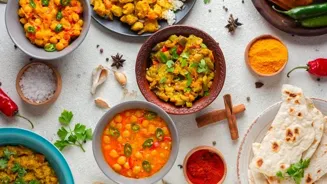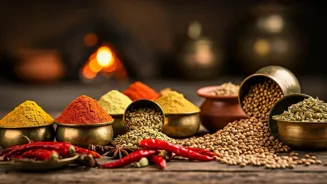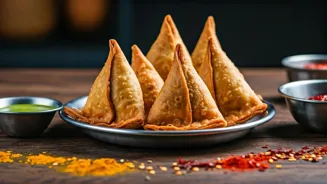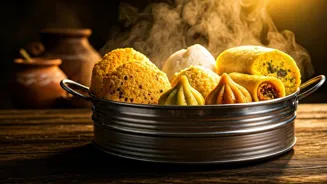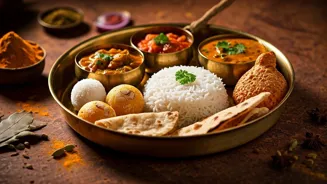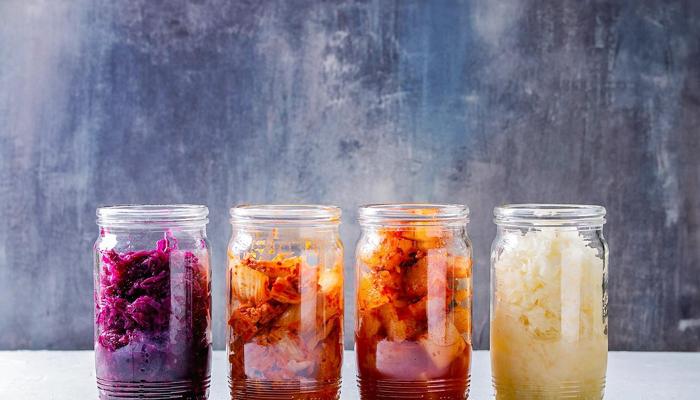Dive into the world of Indian curries: a journey through flavors & regions. Explore the secrets behind their appeal
India, a land of vibrant colors, diverse cultures, and of course, an incredibly rich culinary
heritage. Among the many dishes that define Indian cuisine, the humble curry holds a special place. But what exactly is "curry?
" It's not just one dish, but a whole world of flavors and textures, each region boasting its own unique style and ingredients. Let's embark on a flavorful journey to understand the different types of Indian curries and discover the secrets behind their irresistible appeal.
Exploring rich, creamy North Indian curries with aromatic spices and luxurious textures
Our exploration begins in the north, where curries are often rich, creamy, and aromatic. Think of dishes like Navratan Korma, a medley of nine different vegetables cooked in a cashew-based gravy, or Palak Paneer, where soft cubes of Indian cheese swim in a luscious spinach sauce.
The use of cream, yogurt, and nuts is abundant, lending a luxurious texture to these curries. Spices like cardamom, cumin, coriander, and garam masala are generously used, creating a warm and inviting aroma that fills your kitchen.
North Indian curries are often paired with naan, roti, or rice, making for a satisfying and wholesome meal. The cooking techniques usually involve slow simmering and braising, which contributes to the depth of flavors in the curries.
North Indian cuisine is influenced by Mughlai traditions, hence the creamy, richer textures and the use of nuts and dried fruits. The emphasis is often on balance, with sweet, spicy, and tangy notes harmoniously blended.
Popular vegetarian options also include Chana Masala which is a tangy chickpea curry and Aloo Gobi which is a delectable combination of potatoes and cauliflower.
Flavors of Eastern Indian curries: subtle, veg-based, unique blends, minimal oil
Moving towards the east, the flavors become more subtle and nuanced. Bengali cuisine, known for its seafood and use of mustard oil, offers a variety of vegetable-based curries that are light yet flavorful.
Shukto, a unique Bengali curry, features a complex blend of bitter gourds, potatoes, drumsticks, and other vegetables simmered in a light gravy. The bitterness of the vegetables is balanced by the sweetness of milk and a touch of sugar, creating a truly unforgettable taste.
Another popular dish is Aloo Posto, where potatoes are cooked in a creamy poppy seed paste. This results in a smooth and nutty curry that is both comforting and satisfying.
The use of panch phoron, a blend of five spices (fenugreek, nigella, cumin, mustard, and fennel), is a hallmark of Bengali cuisine, adding a distinctive aroma and flavor to the dishes. The Eastern region also features bamboo shoot curries in states like Assam and Meghalaya.
The flavors here are often influenced by Southeast Asian cuisines, with a focus on fresh herbs and subtle spices. A key feature of Eastern Indian curries is the use of minimal oil, allowing the natural flavors of the vegetables to shine through.
South Indian curries with bold flavors, spices, coconut milk, and Ayurvedic influence
As we travel south, the heat intensifies, and the flavors become bolder. South Indian curries are characterized by the generous use of spices, especially red chilies, mustard seeds, curry leaves, and tamarind.
Sambar, a lentil-based vegetable stew, is a staple in South Indian households, often served with idli, dosa, or rice. Avial, a mixed vegetable curry cooked in coconut oil and yogurt, is another popular dish, originating from Kerala.
The use of coconut milk is prevalent in many South Indian curries, adding richness and creaminess. The cooking techniques often involve tempering spices in oil, which releases their aroma and flavor.
South Indian cuisine is heavily influenced by Ayurveda, and many dishes are believed to have medicinal properties. The focus is on using fresh, seasonal ingredients and incorporating spices that aid digestion.
The use of tamarind lends a tangy flavor to many dishes, while the addition of jaggery provides a hint of sweetness. Rasam, a thin and watery soup-like curry, is another South Indian specialty, often served as a digestive aid.
Exploring bold flavors of Maharashtrian and Gujarati cuisines
Heading west, we encounter the robust flavors of Maharashtrian and Gujarati cuisines. Maharashtrian curries are often spicy and tangy, with the use of peanuts, sesame seeds, and jaggery being common. Misal Pav, a popular street food, features a spicy sprout curry served with bread rolls.
The use of goda masala, a unique blend of spices, is a signature of Maharashtrian cuisine. Gujarati curries, on the other hand, are known for their subtle sweetness and use of lentils and vegetables.
Dhokla, a steamed lentil cake, is a popular snack, while Undhiyu, a mixed vegetable casserole cooked underground, is a winter specialty. The use of sugar or jaggery is common in many Gujarati dishes, balancing the spiciness of the chilies and other spices.
Groundnut oil is often used for cooking, adding a distinctive flavor to the dishes. Theplas, flatbreads flavored with spices and vegetables, are a staple in Gujarati households, often served with yogurt or chutney.
Indian curries: diverse, flavorful, cultural; key is experimentation
The versatility of Indian curries lies in their adaptability and the endless possibilities of combining different ingredients and spices. Whether you prefer a creamy and mild curry or a fiery and tangy one, there's a curry out there for everyone.
Exploring the different types of Indian curries is not just about tasting delicious food; it's about understanding the culture, history, and traditions of this incredible country.
Each region's unique climate, available ingredients, and cultural influences have shaped its culinary landscape, resulting in a diverse and flavorful array of curries. From the mountains of the north to the coastal regions of the south, every bite tells a story.
Experimenting with different spices and techniques is key to mastering the art of Indian curry making.
Explore diverse Indian cuisine for delicious curry adventures
So, the next time you're craving a curry, don't just reach for the same old recipe. Take a leap of faith and explore the vast and varied world of Indian cuisine. Discover new flavors, experiment with different ingredients, and let your taste buds embark on a delightful adventure.
With commitment and curiosity, you can bring the magic of Indian curries to your own kitchen. Remember, the beauty of Indian cooking lies in its flexibility and the freedom to customise dishes to match your own palate.
Don't be afraid to experiment with proportions of different spices or try substituting one ingredient with another. The most important thing is to enjoy the process and savour the delicious results. Happy cooking!
AI Generated Content. Glance/InMobi shall have no liability for the content